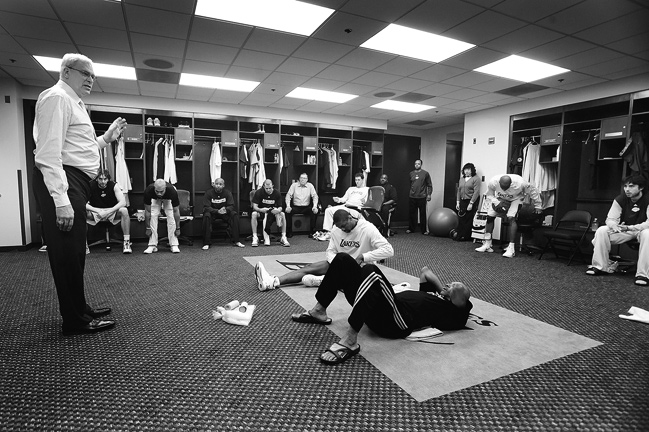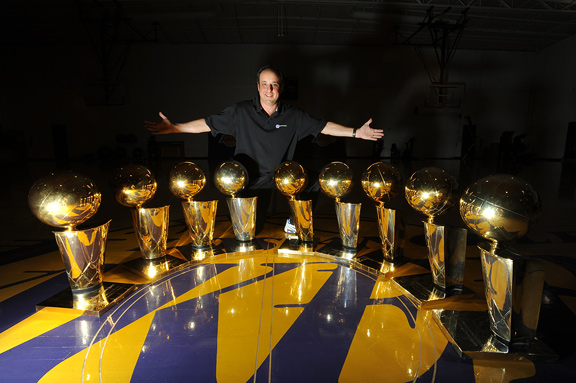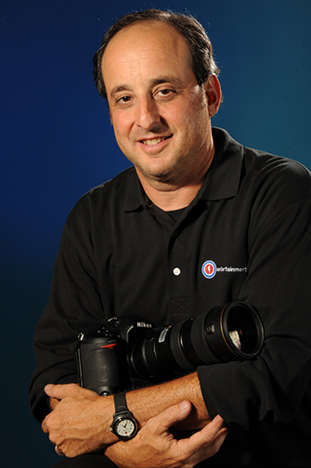
Photo by Andrew D. Bernstein, from Journey to the Ring
Like many of the professional athletes he captures on film, Photography and Imaging alumnus Andrew Bernstein is recognized as an all-star in his respective field. As NBA Senior Official Photographer and NBA Photos Senior Director, Bernstein’s photography has appeared on thousands of magazine covers around the world.
What’s different about Bernstein’s work is the unique personal rapport that he’s developed with the athletes he shoots, allowing him exclusive access to behind-the-scenes moments. His work has been exhibited in solo shows around the country, including a 20-year retrospective of his work in 2004. Bernstein is among just four photographers whose work was selected for permanent exhibit in the Naismith Memorial Basketball Hall of Fame. He was also instrumental in the development and use of the multiple-camera Flash Wizard II system, which revolutionized indoor sports action photography. His most recent book, Journey To The Ring: Behind the Scenes With The 2010 NBA Champion Lakers, written by Lakers coach Phil Jackson, chronicles the team’s season leading up to the championship.
Just in time for the NBA playoffs, we caught up with Bernstein to talk to him about basketball, photography and everything in between.
Dotted Line: Tell us about what you do.
Bernstein: I am the team photographer for the NBA’s two local teams, the Lakers and Clippers. I travel with the teams and cover all the major NBA events—Olympic Games, USA Basketball, WNBA, All-Star Games, Finals. As a senior director, I oversee various team photographers, mostly in the Western Conference. With my boss, the VP of NBA photos, we manage photography throughout the league.
I started working as a freelance photographer for the NBA in 1983. That year’s NBA All-Star Game was my first assignment. I continued freelancing for them and in 1986, helped create the position of official NBA photographer. It was a contract position, and I continued that in that manner until I became an employee of the NBA.
I’ve worked as the team photographer for basically every team and every venue in L.A. since then. I was the Dodgers team photographer from ’84 to ’95. And I’ve become the director of photography for AEG’s two main facilities, the Nokia Theater and Staples Center. I have a crew of five or six people, depending on what’s going on that time of year. We’re responsible for photographing every event in these venues, sporting or otherwise. In addition, I’ve been fortunate to run a successful business, Andrew D. Bernstein and Associates Photography, Inc.
Dotted Line: Which sport do you enjoy photographing the most? Is there one that’s more difficult to capture?
Bernstein: I’ve shot every sport known to man. Baseball was very tedious and challenging because of the boredom factor— sometimes you can go an entire game without really getting a great picture.
When you shoot a hockey or football or a basketball game, though, something’s always happening. It makes it fun to shoot. I love shooting football—I shot UCLA football for five years, and shot the Raiders and Rams when they were in L.A. Hockey is probably the hardest to photograph, because we’re physically limited to where we’re allowed to position ourselves and shoot—we have to shoot through a little hole cut in the boards beside the rink. Not to mention, it’s very fast moving, with players coming toward and away from you at a fast speed. It can get crazy.
Dotted Line: Is there a particular assignment that’s been the most fun to shoot?
Bernstein: I’ve been fortunate to have a career with a lot of fun, fantastic assignments. But the best would probably have to be covering the ’92 Dream Team, from beginning to end. It was a seven-week assignment, from the first day of training camp in San Diego, all the way through winning the gold in Barcelona. Every moment of that experience, and that team, was just once-in-a-lifetime. It was just a fabulous experience, from going to practice to getting to know these mega-superstars. Not to mention being part of history—going to Barcelona and seeing them win the gold. It is something I’ll never forget.

Photo by Andrew D. Bernstein
Dotted Line: Do the athletes you photograph regularly ever become friends?
Bernstein: Absolutely. My career has become based on the great relationships I’ve formed with athletes like Magic Johnson, Shaquille O’Neal, Kobe Bryant, Tommy Lasorda—all the athletes and team personnel I’ve gotten to known over the years. Phil Jackson is also a good friend—I’ve covered all 11 of his championships.
Dotted Line: Tell us about your new book, Journey To The Ring: Behind the Scenes With The 2010 NBA Champion Lakers.
Bernstein: For 30 years I’ve been looking for that one special project—a long-term project done in black and white. A project where I had total creative control, and could just do it from the heart. After the Lakers won the 2009 championship, I proposed the idea—following the Lakers for an entire year—to a publisher, Time Capsule Press, and talked to Lakers coach Phil Jackson about it, and both loved the idea. Phil was very supportive, and he’s a big fan of black and white photography. I started shooting the project the first day of Lakers training camp.
Dotted Line: Were you hoping that the Lakers would win the NBA World Championship again that year?
Bernstein: We didn’t know that we would win again, but we were committed to doing the book regardless. Just the title, Journey to the Ring—it truly is a journey, and Phil is all about journeys. We wanted to show this journey no matter how it ended. And of course, it makes it that much better of a Hollywood ending that they actually won the title and defended their championship.
This book was a true collaboration between Phil and me. We both had our visions for the book, and melded them together. My photos support what he wrote, and he wrote things to support my photos. That’s true collaboration.
Dotted Line: How is sports photography different from say, fine art or advertising photography?
Bernstein: Well, what was great about Art Center that I had to know all of those disciplines. I had to know how to shoot a fashion spread, and I had to know how to shoot a still life, and I had to know how to light a person or an object. I got a well-rounded, technical background from Art Center. I wasn’t the most creative guy in my class by far, but technically, I was pretty good. And I learned what I needed to learn, which really benefited me.
So then, as a sports photographer, I was able to add other spokes to the wheel, if that makes sense. Besides just being a really good action photographer, for example, I knew how to light, I knew how to do a portrait. I knew how to do an advertising shoot, those kinds of things. It gave me an edge out in the real world.
Dotted Line: Your 16-year-old son Michael is an aspiring photographer. What’s that like to experience?
Bernstein: It’s neat, it’s a really a full circle experience for me. He’s already been to Art Center—he took an Art Center for Kids summer workshop taught by Gail Howland. I came to pick him up one day, and saw him there, hard at work in the black-and-white lab I used as a student. He was literally sitting in my old edit bay. It was the most amazing moment, seeing him sitting there.
Dotted Line: Tell us about your time at Art Center. Do you have any favorite memories?
Bernstein: I’ve got a ton. Faculty-wise, Bill Robbins was one of my earliest mentors and teachers. I started working for him in his studio outside of class. He had a major client that required a lot of traveling, so I went with him on the road. It taught me so much. He and I forged a great friendship and relationship, and we’re still friends today. And Jim Caccavo was so instrumental in shaping me as a person, a photographer and human being. He taught the documentary photojournalism class, probably the only one Art Center offered, and I loved it.
Dotted Line: What advice do you give aspiring photographers?
Bernstein: Real-world experience, like I got with Bill, is so valuable. I always tell people that you’ve got to get a solid photography education first, and then you have to assist somebody. You have to learn hands-on even if that means doing it for free, carrying somebody’s bags, or picking them up at the airport. You’ll still learn something from just being around them.











Andy , We were friends 33 years ago when yo were taking Pictures for “The Collegian” at U MASS & We lived in JA& JQA! Congratulations on your many accomplishments! Always new You were destined for Greatness!!